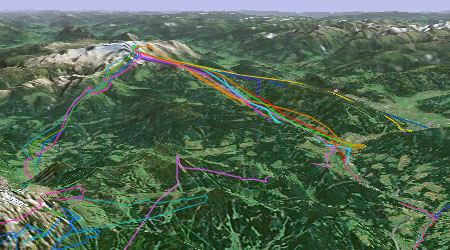Until this morning I had never heard of the XAlps, “the ultimate paragliding race,” where contestants paraglide 800km across the Alps, east to west, without mechanized help. The race started today, August 1, in Austria. You compete by climbing to the tops of mountains with your equipment and then jumping off, gliding as far west as possible, climbing up the next one, jumping off, and repeating this all the way into Monaco.
I found all this out via Geared Up blog, which also pointed out that the 17 contestants this year are wearing GPS trackers, whose data get turned into Google Earth KML files, available for download.
Aha! The future of sport, I thought, only to find the reality akin to making it to Lake Geneva and then drowning: The KMZ files are very hard to find, are offered as static downloads, and even then only on a per-contestant basis. That’s so close, so why not go the last mile?
Luckily, the individual KML files automatically get published to the same URL and are regularly replaced. This made constructing dynamic network links out of the 17 files and collecting them into one downloadable, annotated KMZ relatively straightforward.

I’ve set them to update every hour. The gliding paths they produce are wonderful, punctuated by climbs up the next hill. It’s truly the best way to see this race, and every future endurance race. (I’m rooting for Team 9.)